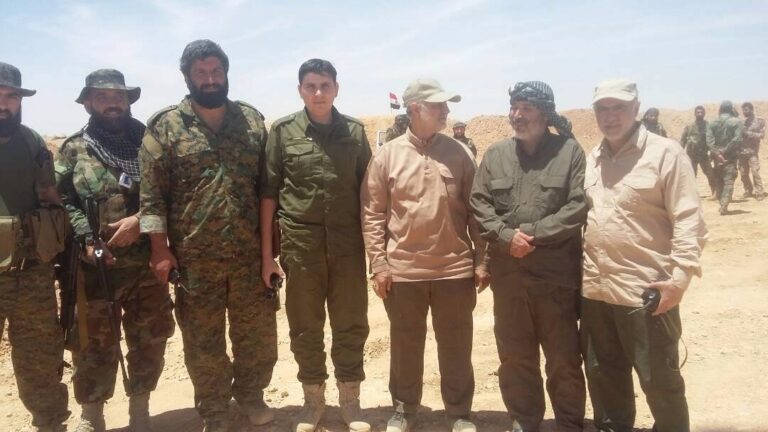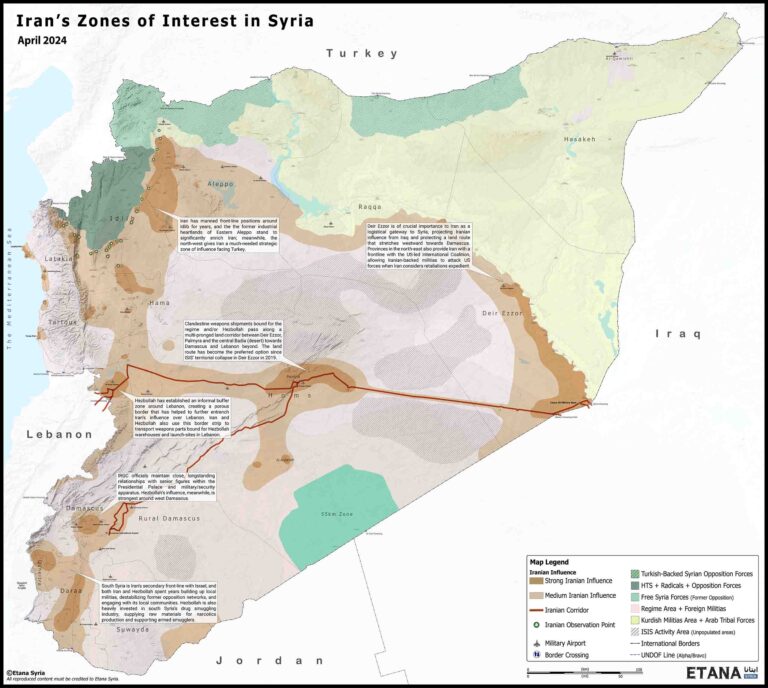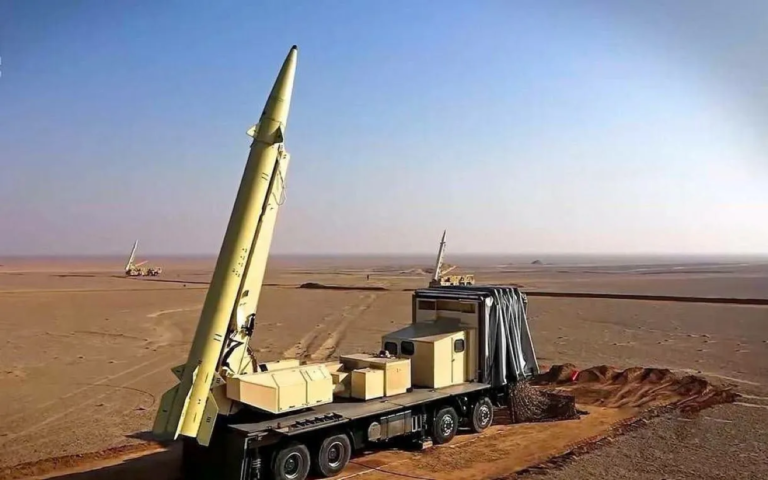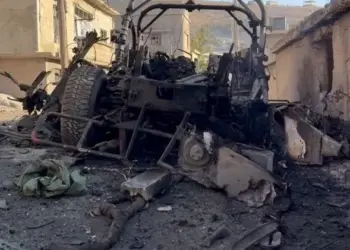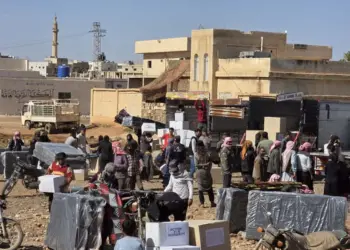Key findings
- Assad is beholden to Iran but also strategically aligned with its ideology and objectives. Years after Iran started entrenching itself in Syria, the country is now undeniably an Iranian client-state whose territory, resources and institutions can be utilized at Iran’s behest.
- Iran’s entrenchment in Syria is built on horizontalism with the Syrian regime—it exists in parallel to, alongside and within regime structures of authority. The Quds Force, a branch of the Islamic Revolutionary Guard Corps (IRGC), is the main body responsible for managing Iran’s presence in Syria.
- Since 7th October, Hezbollah and other Iranian-backed actors have been given free rein to launch attacks against Israeli territory from south-west Syria. The Assad regime is both unwilling and unable to intervene.
- Despite a persistent narrative insisting otherwise, Iran is not in competition with Assad’s other major external backer, Russia. Rather, Tehran and Moscow complement one another and share tacit understandings and complementary arrangements to avoid disputes and share power and/or territory.
The long-simmering conflict between Israel and Iran has escalated significantly since October, with Syria frequently at the center of the conflict. The recent large-scale attacks led by IRGC forces on Israeli territory saw a barrage of Iranian drones and missiles flying over Syrian and Iraqi territory, indicative of Tehran’s grip on authorities there.
The current war in Gaza has exacerbated tensions, bringing Iran and Israel into closer conflict than ever before. In the weeks following Hamas’ 7th October incursion and Israel’s brutal assault on Gaza, Iranian-backed militias in south Syria stepped up their attacks targeting Israel. Now, following a deadly Israeli strike on Iran’s consulate in Damascus, Syria is once again a critical theater for regional powers to pursue their ambitions. For now, this means Iran will continue to prioritize maintaining its presence in Syria and Iraq, from which it will continue to threaten not only Israel, but the security of the broader region.
Iran’s Presence in Syria
Iran saw Syria’s 2011 crisis as both an emergency and opportunity, and consequently has been building its foothold in Syria for more than a decade. The IRGC reacted swiftly to protests, both to stabilize a longstanding ally and to entrench itself across the country, particularly after the intervention of Lebanese Hezbollah and a growing constellation of Iranian-backed militias after 2013. As a result, Iran now has unprecedented strategic depth in the region and utilizes Syrian territory for developing and transferring weapons and launching attacks.
Iran is focused on preserving the Assad regime while utilizing Syrian territory for its own strategic objectives. However, what is often misunderstood is how Iran operates in Syria to project influence via its proxies and the Assad regime, while also leveraging its interests in tacit partnership with Russia.
Iran utilizes Syria’s military-security apparatus for its own ends but does not seek top-down, direct control over it; rather, it embeds itself within existing military-security structures. Iran’s entrenchment in Syria is therefore built on horizontalism with the Syrian regime—it exists in parallel to, alongside and within regime structures of authority. The horizontal, clientelist nature of Iranian penetration means there is no clearly visible chain of command or distinct hierarchy through which Iranian involvement can be clearly delineated.
Similarly, militia activity is often obscured. Iranian and Hezbollah operatives act on orders and permissions from the Presidential Palace and their own command-chains while moving around the country clandestinely.
Meanwhile, with Russia now less involved in Syria than at any point in the conflict, the primary onus for regime reform now falls to Iran—an unfortunate status quo given that Iran has demonstrated no interest in preserving Syrian state institutions or reform of its constituent parts so long as the IRGC, Hezbollah and its proxies can use the regime and Syrian territory to further Iran’s expansionist strategic objectives in the region.
The present-day regime is no longer a strategic ally for Iran. Rather, it is an indebted client-state that owes its survival to Iran.
Iranian Operations & Zones of Interest in Syria
Iran has carved out carefully selected and highly effective redoubts of influence and control throughout Syria. Across all theatres, Iran manages pyramidal structures that thread Iranian influence into strategically useful layers of the Syrian military-security apparatus. Iran supports a wide array of militias inside Syria comprising tens of thousands of troops: Iraqi, Lebanese and Syrian branches of Hezbollah, Iraqi Popular Mobilization Forces (Hashd al-Sha’abi, PMF), Liwa al-Fatemiyoun, Liwa al-Quds and Liwa al-Zeinabiyoun. These proxy militias provide Iran with a far reach but, critically, plausible deniability as well.
On the ground, Iran maintains up to six main zones of strategic interest through the IRGC’s Quds Force and proxy militias, including Hezbollah:
Iranian Corridor & Weapons Development
Today, Syria increasingly serves as an Iranian arsenal and staging-post for Iranian-backed militia activity, as a conduit for weapons development and transfers on behalf of Iranian allies elsewhere in the region (and chiefly Hezbollah in Lebanon) and as a staging-post for militia attacks against Israel and its US backers.
IRGC-backed militias and Syrian intelligence agencies, collaborating with affiliated smugglers and organized crime networks, facilitate the transfer and distribution of advanced weapons systems among Hezbollah and Syrian regime forces.
Syria now performs the dual role of manufacturing weapons while also providing the facilities and logistical back-up to ship advanced weapons to Iran’s other allies in the region—chiefly, Hezbollah in Lebanon. With the regime’s role in the Axis of Resistance now more passive than before, Iran has come to see its ally as a forward arsenal that stores advanced weapons in strategic positions facing Israel/Palestine, the US-led International Coalition, and western-friendly regional states.
Iran-Russia Relationship
Despite a persistent narrative that Iran and Russia are in constant competition in Syria, the two countries in fact complement one another and share tacit understandings and complementary arrangements to avoid disputes and share power and/or territory.
Russia’s gradual disengagement from Syria following its invasion of Ukraine in February 2022 has expanded the space available to Iran entrenchment in Syria. With Russia now primarily focused on Ukraine, Iran can exert greater pressure on Syria’s Presidential Palace. While Iran has not taken over Russia’s role, Moscow’s pullback does give more opportunities through which Iranian-backed actors can pursue Tehran’s strategic interests on the ground.
Post-7 October Developments
Since October, Israel has targeted Hezbollah and militia launch-sites used to fire missiles into the occupied Golan Heights. The last two months saw unprecedented escalations. Israeli jets have increasingly targeted senior IRGC and Hezbollah commanders with greater frequency and accuracy. Meanwhile, a series of Israeli ground incursions into Quneitra province, with the aim of detaining militia assets and externalizing border defenses, points to the complete collapse of Syria’s territorial integrity (for which both Iran and Israel are responsible).
In step, Israeli attacks against regime bases linked to Iranian-backed militia activity communicate to the regime that it intends to inflict heavy losses so long as Damascus fails to curb Iran’s use of Syrian territory to attack Israel. However, the regime is now backed into a corner regarding Israel: Iran is the one directing the conflict in Syria, not the regime.
Interactions with Civilian Communities
Iran’s explicit and implicit ideological claims to being a pious, representative defender of the interests of communities across the region are supposed to place Iran in opposition to the region’s Sunni military dictatorships and autocratic monarchies as well as the “imperialist” west. In reality, Iran and its proxies imperil and/or actively repress civilian communities wherever they operate.
From the first months of Syria’s 2011-2012 uprising, IRGC advisers aided and abetted the most sectarian, brutal elements of the regime apparatus. This, in turn, helped define the regime’s hardline response after mid-2011, a response characterized by mass detentions and enforced disappearances, massacres and forcible displacements, all designed to irreparably punish restive areas that had seen anti-regime protests and/or armed activity and ultimately homogenize Syrian society in the process.
Militias frequently use, and confiscate, civilian infrastructure. In Aleppo, this nefarious role has long-term impacts on the housing, land and property (HLP) rights of in situ and displaced residents. When Iranian actors are involved—but particularly in Damascus, Aleppo and north-west Syria—HLP policies are far more likely to be sectarianized in favor of Alawi or Shia communities, leading to demographic shifts in areas where Iranian influence is strongest.
Practices like these, and the fear of repercussions from Israeli strikes, feed into local grievances. Anti-Iranian chants and slogans have remained a mainstay of anti-regime protests across south Syria ever since the regime’s 2018 takeover—including, most recently, the sustained anti-regime protest movement in Suwayda.
Recommendations
Dealing with the reality of Iran’s entrenchment in Syria requires a long-term regional strategy, rather than a piecemeal, reactionary approach that relies on ad hoc tactical responses to provocations viewed through narrow, country-by-country lenses. Iran’s entrenchment in Syria is inherently linked to its regional ambitions—most immediately in Lebanon and Iraq—to alter the security and political balance of the wider region. A coherent policy approach that accounts for Iran’s regional ambitions may not be enough at this point to push it out of Syria (or Lebanon or Iraq), but even a restrained—rather than emboldened—Iranian presence is still a preferred outcome for regional stability.
